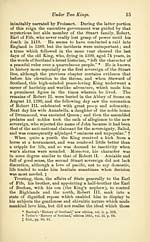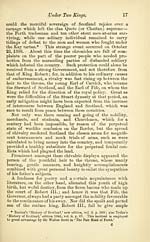Stuart dynasty
(36) Page 16
Download files
Complete book:
Individual page:
Thumbnail gallery: Grid view | List view

16 The Stuart Dynasty.
best able to judge longed to behold in a King o' Scots at
this period.
The weakness of the situation thus created became
apparent when in the first place the northern Viceroy, the
Earl of Buchan, displayed a savagery which seriously
damaged the popularity of the throne which he misrepre-
sented : * and had it not been for the address with which
the Earl of Fife renewed the league with France, whereby
truce between the three countries was prolonged and rati-
fied by the King, Scotland might have been confronted with
the direst peril, f
The public safety seems to have been preserved at this
time by the forethought of the Earl of Fife — a statesman
whose record can by no means be purged of all self-seeking,
or cleared decisively of stains which suspicion casts upon
his character, but whose hand is visible in securing many
benefits for his country. But the state of barbarism to be
dealt with was simply inconceivable in a land where Christ-
ianity had held sway for more than eight hundred years,
and where the dictates of chivalry were recognised, and its
civilising influence admired and welcomed.
Indeed we find the high-minded King persuaded to pre-
side over an exhibition of barbarism early in his reign. A
quarrel between the Highland clans Kay and Quete (or
Chattan) threatened to convulse the mountain country above
Perth, so thirty champions from each bellicose faction were
marshalled on the North Inch at Perth. It is a beautiful
piece of level ground, by which the river Tay j^asses rippling
on with music sweet. The spectacle of the Scottish King
enthroned on a platform as umpire in these strange High-
land games were doubtless impressive. But the bloodshed
which ensued must have been revolting to the gentle King
Robert III., who doubtless commiserated in his heart the
recalcitrant deserter from the clan Chattan who cast himself
into the Tay, and swimming across fled to the woods. Nor,
with all knightly respect for bravery such as that of the
Perth armourer, Henry of the Wynd, who filled up the gap,
* Tytler's 'History of Scotland,' edition 1841, vol. iii. p. 64. Evidence of
the Buehan's vandalism is, alas ! apparent in Elgin Cathedral, which this so-
called Wolf of Badenoch partially gave to the flames. He burnt the beautiful
choir, and much of Elgin itself, in June 1390, to revenge a private grudge
against the Bishop, Barr by name. — ' Survey of Province of Moray,' edition
1808, p. 81.
t '.Records of the Parliament of Scotland,' A.D. 1390, p. 136.
best able to judge longed to behold in a King o' Scots at
this period.
The weakness of the situation thus created became
apparent when in the first place the northern Viceroy, the
Earl of Buchan, displayed a savagery which seriously
damaged the popularity of the throne which he misrepre-
sented : * and had it not been for the address with which
the Earl of Fife renewed the league with France, whereby
truce between the three countries was prolonged and rati-
fied by the King, Scotland might have been confronted with
the direst peril, f
The public safety seems to have been preserved at this
time by the forethought of the Earl of Fife — a statesman
whose record can by no means be purged of all self-seeking,
or cleared decisively of stains which suspicion casts upon
his character, but whose hand is visible in securing many
benefits for his country. But the state of barbarism to be
dealt with was simply inconceivable in a land where Christ-
ianity had held sway for more than eight hundred years,
and where the dictates of chivalry were recognised, and its
civilising influence admired and welcomed.
Indeed we find the high-minded King persuaded to pre-
side over an exhibition of barbarism early in his reign. A
quarrel between the Highland clans Kay and Quete (or
Chattan) threatened to convulse the mountain country above
Perth, so thirty champions from each bellicose faction were
marshalled on the North Inch at Perth. It is a beautiful
piece of level ground, by which the river Tay j^asses rippling
on with music sweet. The spectacle of the Scottish King
enthroned on a platform as umpire in these strange High-
land games were doubtless impressive. But the bloodshed
which ensued must have been revolting to the gentle King
Robert III., who doubtless commiserated in his heart the
recalcitrant deserter from the clan Chattan who cast himself
into the Tay, and swimming across fled to the woods. Nor,
with all knightly respect for bravery such as that of the
Perth armourer, Henry of the Wynd, who filled up the gap,
* Tytler's 'History of Scotland,' edition 1841, vol. iii. p. 64. Evidence of
the Buehan's vandalism is, alas ! apparent in Elgin Cathedral, which this so-
called Wolf of Badenoch partially gave to the flames. He burnt the beautiful
choir, and much of Elgin itself, in June 1390, to revenge a private grudge
against the Bishop, Barr by name. — ' Survey of Province of Moray,' edition
1808, p. 81.
t '.Records of the Parliament of Scotland,' A.D. 1390, p. 136.
Set display mode to:
![]() Universal Viewer |
Universal Viewer | ![]() Mirador |
Large image | Transcription
Mirador |
Large image | Transcription
Images and transcriptions on this page, including medium image downloads, may be used under the Creative Commons Attribution 4.0 International Licence unless otherwise stated. ![]()
| Histories of Scottish families > Stuart dynasty > (36) Page 16 |
|---|
| Permanent URL | https://digital.nls.uk/94818198 |
|---|
| Description | A selection of almost 400 printed items relating to the history of Scottish families, mostly dating from the 19th and early 20th centuries. Includes memoirs, genealogies and clan histories, with a few produced by emigrant families. The earliest family history goes back to AD 916. |
|---|

